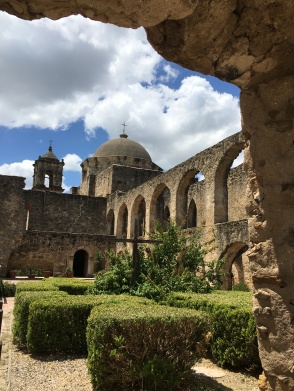August in Texas is hot. Cumulus clusters float like candy floss across lapis skies. The beauty is as intense as the heat. A cloudburst delivers a brief respite – rain bouncing off the hard ground of the southern prairies in hard pellets.
Entering the g ates of the Mission San José y San Miguel de Aguayo just south of San Antonio, Texas, the seventh most populated city in the United States, it is easy to imagine the plaza filled with Franciscan friars, soldiers and men, women and children living their lives predominantly within the confines of the mission walls.
ates of the Mission San José y San Miguel de Aguayo just south of San Antonio, Texas, the seventh most populated city in the United States, it is easy to imagine the plaza filled with Franciscan friars, soldiers and men, women and children living their lives predominantly within the confines of the mission walls.
Pincered between the more aggressive nomadic Lipan Apaches from the North and by colonists from Spain eager to increase their footprint in the New World, those men, women and children were members of the hunter-gatherer tribes, known collectively as Coahuiltecans (Kwa-weel-tekens). Funded by Spain when prospects of riches north of the Rio Grande faded, the missions became the driver for the spread of Catholicism, though they did little to limit the spread of foreign disease.
Our screens today are filled with images of forced migrations – peoples fleeing war, genocide, politics and poverty. Some make it eventually to countries willing to share the burden of refugees, others spend years, sometime decades, in camps initially built to be temporary. Many have fled with few possessions, but in their souls they carry their culture – the essence of who they are.
With the years, particularly if the country resettled in is of an entirely different culture, the home culture becomes diluted. Becomes a marriage of cultures, a blending of mores. And yet high days and holidays are still celebrated, perhaps without the exact ingredients, but near enough to satisfy our instinct to recognize and belong. Over generations those cultures become evermore diluted until we are left with sometimes just the merest hint of our ancestry – a darker skin, an almond-shaped eye, or with words alone. I am German American. I am Chinese American, and so on. It has been a slow iterative process, which is occasionally reversed through sheer will and determination of a man or woman many generations removed – but that original culture can never be wholly reclaimed. Think Kwanzaa, celebrating an African heritage and created by Maulana Karenga in 1966–67 for African Americans. (See blog Dec 31st, 2010)
Imagine then the intensity of culture change for the Coalhuiltecans who, driven by the fear of bows and arrows from the North and European diseases from the South, placed their fate in the benign hands of men like Friar Antonio Margil de Jesús, founder of the Mission San José.
The five missions along the San Antonio River, all modeled on Spanish villages, gave protection from marauders but not disease. Many died. But their story is not decades in the making. Rather it is one of willing subjugation. By entering the mission gates, the Coalhuiltecans, in exchange for refuge gave up not just a way of life but dialects, religious practices – an entire culture disappearing essentially overnight.
From hunter gatherer, at one with the seasons, carrying supplies in intricately made baskets in their search of food, they became Catholic neophytes living by a bell pealing around the walled missions. Mass three times a day. Spanish and Latin became their language. In exchange for their freedom, skills were taught and the Coalhuiltecans became weavers, carpenters, masons, blacksmiths, farmers and soldiers.
Wandering around the plaza, ducking into the Indian living quarters, taking in the quiet beauty of the mission church, a limestone edifice built in the Spanish colonial Baroque style begun in 1768 when the mission was home to 350 Indians, there is a serenity I had not expected.
My thoughts jumped to modern-day camps, enclosed by razor wire, but built essentially to protect, or maybe to contain, the many, many thousands of inhabitants fleeing persecution. I doubt my descendants will walk those camps with a sense of peace, even though cultures may not have not been lost.
And I doubt there will be remarkable innovations left for future generations. Like the series of dams and aqueducts – the acequia system – which irrigated fields surrounding the missions with waters from the San Antonio River. A system still supplying farms today.
For some Coalhuiltecans the strictures of a prescribed life were too great, and they returned to their former way of living, only to die from the original threats. Lost, one culture. For those who remained a new culture evolved and became the bedrock of the Tejano. I am Mexcian American.
The August heat on the southern Texas prairies is intense. But rain will fall, to be collected in dams built under the auspices of Franciscan friars. What, I wonder, will be the legacy of our camps today? What will be the essence of the culture these refugees carry?





